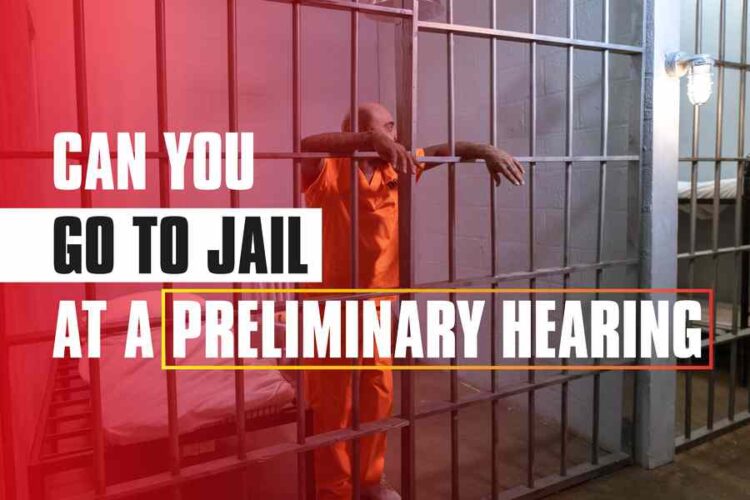If you’ve been arrested for a crime and are facing criminal charges, you will have to go through the legal process. Depending on the severity of your alleged crime and your personal circumstances, your next steps could involve a series of different hearings. A preliminary hearing is one of these stages; it is not an independent proceeding but rather part of the criminal proceedings. A preliminary hearing is also known as an evidentiary hearing or probable cause hearing. It is held before a judge to determine if there is enough evidence to take the case to trial. In this article, we explore whether you can go to jail at a preliminary hearing and what you should know about this stage of the criminal justice process.
Can You Go To Jail At A Preliminary Hearing?
A preliminary hearing is the first court hearing that takes place in criminal cases. It is not a full trial, but it is a more formal hearing that takes place before a case goes to trial. At a preliminary hearing, a judge will determine if there is enough evidence for the case to proceed to trial. If so, the case will then be scheduled for trial. If not, the defendant will be released from custody and the charges may be dropped. A preliminary hearing can lead to either further court proceedings or the end of a criminal case.
Why is there a Preliminary Hearing?
1. To Establish Key Facts
One of the key facts established at a preliminary hearing is the identity of the defendant, as well as the identity of all witnesses. The prosecution will have to prove beyond a reasonable doubt that the defendant is the same person who committed the crime, as well as the witnesses involved, are who they say they are. If the defendant has entered a plea of “not guilty”, then the prosecution will have to present evidence to prove the defendant is, in fact, guilty. Dates, times, and places are essential in proving guilt, as well as establishing a timeline of events to help prove or disprove alibis.
2. To Determine If There Is Sufficient Evidence For Trial
At the preliminary hearing, the prosecution will have to show that there is a reasonable probability that the evidence presented could lead to a conviction. If the evidence is found to be sufficient, then the defendant will have to go to trial, as well as the case will proceed forward. If, however, the judge finds the evidence insufficient, then the case will likely be dismissed.
3. To Decide Whether There Should Be A Jury Or Non-Jury Trial
In some cases, the prosecution and defense may agree to have a jury trial. If the preliminary hearing decides there should be a jury trial, then the judge will set a date for the next proceeding. If, on the other hand, both parties decide there should be a non-jury trial as a result of the preliminary hearing, then there will be a date set for the next proceeding to decide the manner of trial. If the parties cannot reach an agreement on the jury or non-jury trial, the judge will make the decision for them.
4. Because The Defendant Demands One
If the defense thinks the prosecution does not have a strong case against them, then they may choose to have a preliminary hearing. This can happen if the defense believes the prosecution does not have enough evidence or sufficient evidence to prove guilt. If the defense believes they can raise enough doubt about the prosecution’s case, they may want to request a preliminary hearing. If the defense feels that they have a strong enough case and the prosecution’s evidence is lacking, they may request a preliminary hearing to see if the judge agrees with their assessment. The request may be denied, depending on the judge and the strength of the prosecution’s case.
5. Because The Prosecutor Requires One
There are times when the prosecution feels that the evidence against the defendant is so strong that they require a preliminary hearing. This situation can arise if the defense fails to enter a plea, fails to appear in court, or fails to appear for the preliminary hearing. In such cases, the prosecution may want a preliminary hearing so they can move the case forward.
When Can Someone Go to Jail at a Preliminary Hearing?
- The judge can decide to jail you at a preliminary hearing if any of the following applies:
- You are charged with a felony.
- Your bond is set at the highest possible amount
- A warrant has been issued for your arrest
- You have failed to appear in court on another case.
- A bench warrant has been issued for your arrest.
- You have been convicted of a crime.
- You are charged with an additional crime.
- The judge determines that there is enough evidence to take the case to trial.
- The judge finds that you are a flight risk.
- The judge believes that you will not show up for trial.
- If a judge determines at the preliminary hearing that there is enough evidence to take a case to trial, then the defendant may have to go to jail until the trial is over.
- If a judge determines that there is enough evidence to take the case to trial and the defendant is unable to post bail, then the defendant may have to go to jail until the trial is over.
Is Going to Jail at a Preliminary Hearing Rare?
- Going to jail at a preliminary hearing is rare, but it does happen. At the preliminary hearing, the judge will review the prosecution’s evidence to determine if it’s strong enough to take the case to trial.
- If the judge finds that the prosecution has met the standard of probable cause, then the judge will order the defendant to go to jail until the trial is over.
- A judge might do this if the defendant is considered to be a flight risk. The judge will also order the defendant to go to jail if he or she is considered to be a danger to society.
- This might be the case if the defendant has a history of violence or is accused of a very serious crime.
Should You Hire a Lawyer for a Preliminary Hearing?
- If you are accused of a crime and facing criminal charges, you may be required to go to a preliminary hearing. It is a good idea to hire a lawyer for the preliminary hearing. At the preliminary hearing, the prosecution will present evidence against you to a judge.
- The defense attorney will be able to cross-examine the prosecution’s witnesses and provide evidence in favor of the defense. A good lawyer will be able to challenge the prosecution’s case against you at the preliminary hearing. A good lawyer may be able to challenge the probable cause for taking the case to trial.
- If you are accused of a crime, it is a good idea to hire an attorney to represent you at the preliminary hearing. At the preliminary hearing, the prosecutor will likely try to convince the judge that there is enough evidence for the case to move forward. If you have a lawyer who knows how to defend your case in court, then your chances of getting a fair trial will be better.
- If you are charged with a crime and the judge finds that there is enough evidence to move forward with the case, then your trial will probably be scheduled within a few weeks. Even if you are able to post bail, you’ll have to wait until your trial date arrives before you can get out of jail. For a criminal case, this may take several months at the very least. It depends on the speed of the court system in your county. In some counties, it can take years for cases to get through their courts.
Summing Up
It is possible to go to jail at a preliminary hearing, but this is rare. At the preliminary hearing, the judge will review the prosecution’s evidence to determine if it’s strong enough to take the case to trial. If the judge finds that the prosecution has met the standard of probable cause, then the judge will order the defendant to go to jail until the trial is over. A good lawyer may be able to challenge the prosecution’s case against you at the preliminary hearing, which can help to prevent the judge from ordering you to go to jail before the trial is over.









